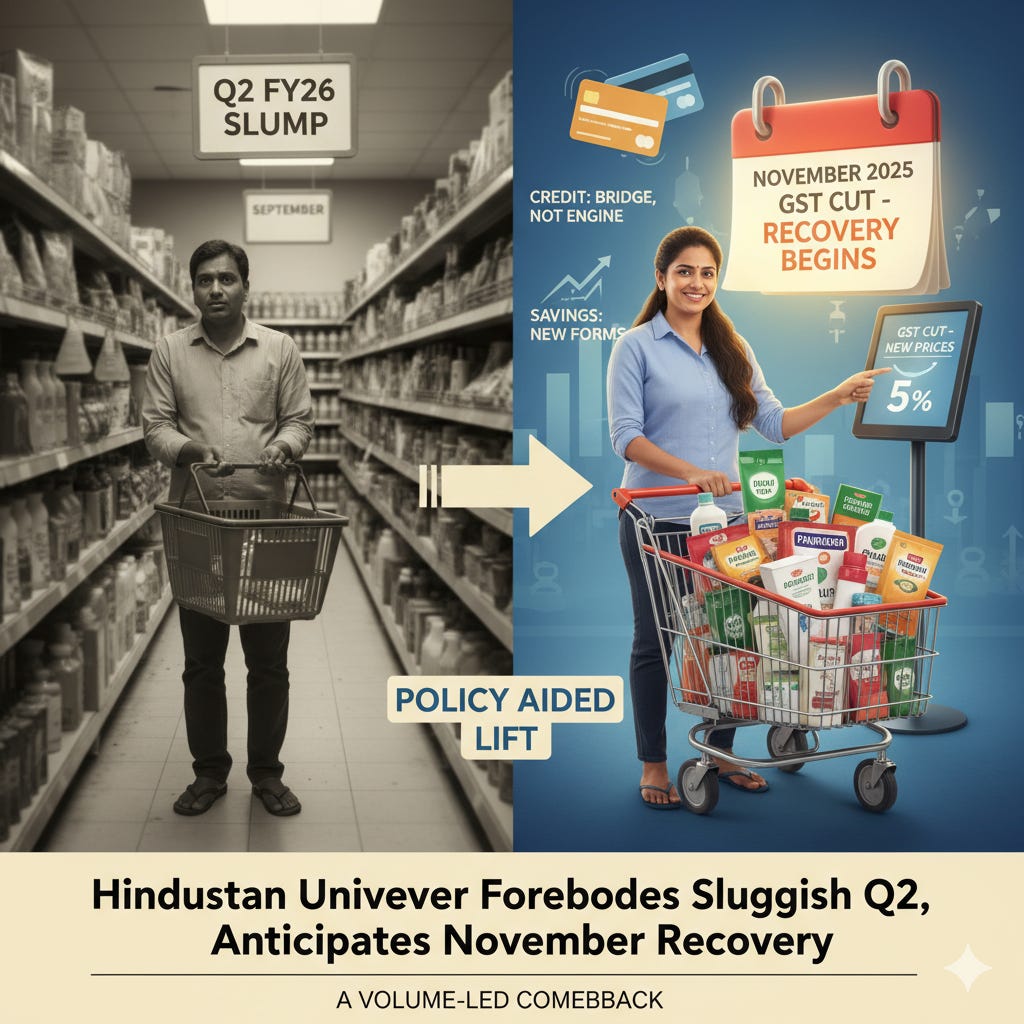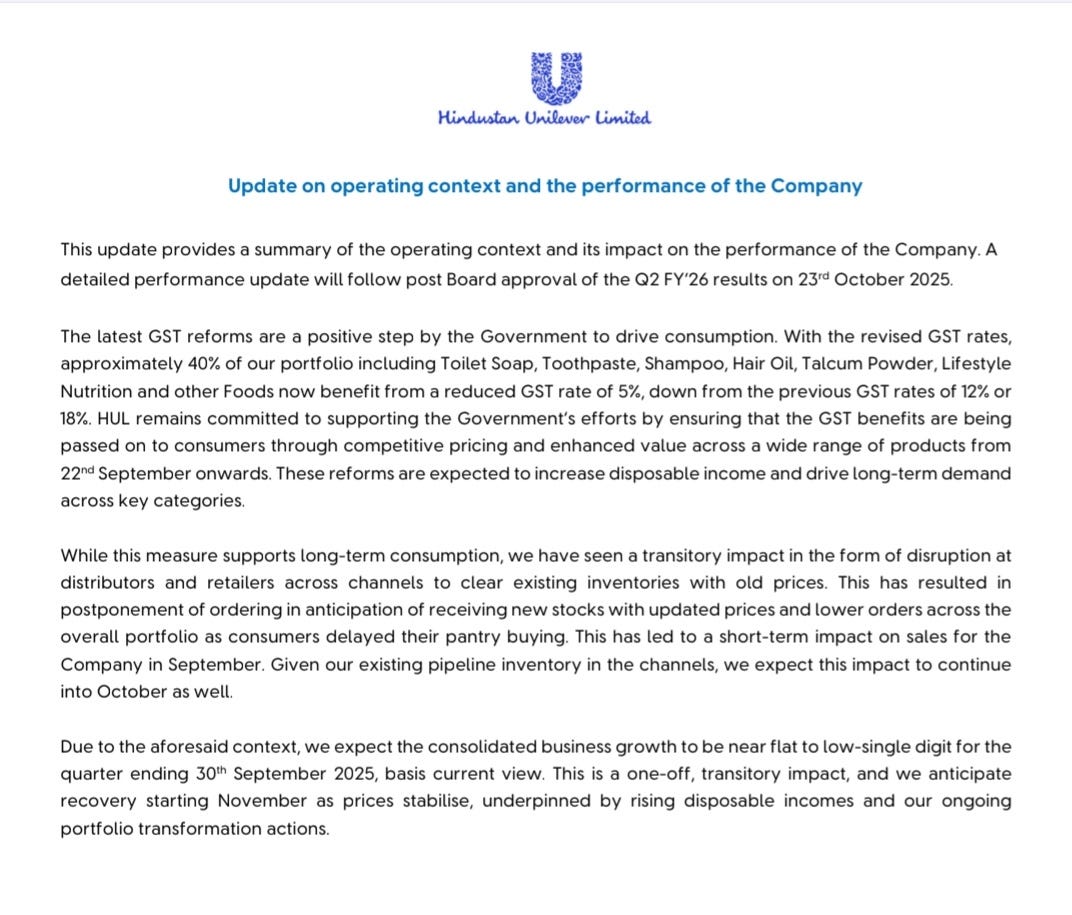Hindustan Unilever Forebodes Sluggish Q2, Anticipates November Recovery
HUL’s Subdued Press Note Amid the GST Utsav, and What It Tells Us.
Author credentials:
KBS Sidhu, IAS (Retd.), former Special Chief Secretary, Punjab, writes on the GST cut, consumer spending and FMCG growth in the context of HUL’s Q2 guidance.
The Spark: HUL’s Press Note and What It Tells Us
“We expect the consolidated business growth to be near flat to low single digit for the quarter ending 30 September 2025. This is a one-off, transitory impact, and we anticipate recovery starting November as prices stabilise.” With that candid closing line—delivered well ahead of the Board of Directors meeting slated for the last week of October to review Q2 FY26 results—Hindustan Unilever set the tone: a muted quarter now, followed by the promise of a policy-driven lift as prices settle and consumer demand returns.
Will the GST Cut Lift Demand—And By How Much?
In staples and personal care, prices matter. A fall from 18% to 5% GST translates into a double-digit percentage reduction in the tax component; 12% to 5% still produces a meaningful single-digit relief. Even when part of the cut appears as extra grammage rather than a visible MRP drop, the shopper’s rupee stretches further. The immediate effect is twofold:
Restocking and release of deferred demand. After the channel flushes old-price stock, households top up baskets they delayed—particularly the ₹5–₹20 price ladder where value packs live.
A step-up in real consumption. Lower effective prices nudge up quantities in categories with price elasticity—personal wash, oral care, entry detergents—especially outside metros.
This is not a stimulus that creates artificial demand; it lowers the friction to buy. The more disciplined the pass-through, the cleaner the volume response.
Confidence or Credit? What’s Powering Urban Spend
A separate, less visible force is financing behaviour. Urban India today buys more often on credit rails—credit cards, EMIs, and pay-later lines embedded in apps. For day-to-day FMCG, wages still fund the bulk of the basket; credit typically bridges timing (buy today, pay next cycle) or funds small splurges (premium beauty, nutraceuticals, multi-packs). That pattern is most pronounced among Gen Z: intensely digital, ferociously price-aware, comfortable using credit for convenience but quick to churn if value slips.
The sustainability test is simple: do repayments keep pace without forcing cutbacks later? If revolving balances on cards rise and the job market tightens, discretionary FMCG will be the first to be trimmed. For now, the GST cut makes the credit–consumption loop less risky by lowering the total bill; but it does not remove the need for income to carry the spend when the statement arrives.
Savings: The Quiet Counterweight to Consumption
Household savings form the cushion that lets families spend confidently and absorb shocks. The composition of savings has been changing: less idle cash in bank accounts, more in fixed deposits at higher rates, and a rising share directed to market-linked instruments via SIPs and small-savings schemes. That reallocation is not inherently bearish; it can be healthy if buffers remain adequate.
Two cautions are worth flagging. First, a drift towards thinner emergency reserves—especially among younger urban households—raises vulnerability to income hiccups. Second, if more consumption is financed by revolving credit rather than transacted credit (paid off monthly), the interest burden quietly eats into future savings. Policymakers don’t need to cap consumption to fix this; transparency on BNPL, financial-literacy nudges, and steady job creation do the heavy lifting. In short: the propensity to save is evolving, not disappearing, and the quality of savings matters as much as the rate.
Indian Brands vs Multinationals: Who Gains From Lower GST?
The GST cut is a tide that lifts all boats, but it favours some hull shapes over others. In foods and staples, Indian champions and regionals already dominate. As affordability improves, their value propositions—trusted quality at sharp price points—become even stickier. In home and personal care, multinational portfolios remain powerful, yet the price–value gap has narrowed dramatically. Indian firms have upgraded efficacy and packaging, matched with surgical price–pack architecture by region and channel. The result is a mix-and-match household: Santoor or a retailer’s brand for handwash, Parachute for hair oil, a prestige shampoo for weekends, Colgate for oral care, and a domestic snack alongside an MNC instant noodle.
Expect share churn within categories, not a one-way swing. Domestic players push hard on value for money and naturals; MNCs defend with R&D-anchored benefits and premium laddering. The winners will be those who adapt fastest to the new price grid and keep distribution ruthlessly tight.
Patanjali: A Case Study in Value, Identity and Trust
Patanjali remains central to the conversation because it fused three currents: Ayurveda credibility, a distinctly Indian identity, and aggressive price points. In categories like personal wash, oral care and staples, its presence keeps shelf prices honest and forces incumbents to sharpen grammage and trade promotions. The brand’s long-run share rests on two pillars: trust (quality, safety, reliable claims) and refresh (formats and aesthetics that speak to younger buyers). If those hold, Patanjali continues to anchor the value end; if they falter, demand doesn’t automatically swing back to multinationals—other Indian incumbents in naturals are well positioned to absorb it.
Growth, Consumer Benefit and the New Price Grid
Sales growth outlook (next 12 months). Expect volumes to lead value. As channels normalise and price points settle, mass categories should show a clear upward bias, strongest in non-metro markets and at the entry price ladder. Value growth follows as volumes scale, even if MRPs step down or grammage steps up.
Consumer benefit. The gain comes three ways:
Visible MRP drops where cuts are simple to communicate.
Stealth value via larger grammage at the same price (a favourite on the ₹5–₹20 rungs).
Richer promotions as brands and retailers compete to lock in habit during the reset.
Profit pools. Near term, margins feel pressure as companies pass through the tax cut and fight for shelf-space. Over time, efficiency (sourcing, manufacturing, route-to-market) and mix (re-igniting premium sub-brands) repair profitability. The discipline will be to keep value packs compelling and maintain a credible ladder to premium.
Market-share mix—macro, not stock picks.
Foods & staples: Indian companies consolidate; regionals and private labels nibble share in commodities and kitchen care where quality is easy to verify.
Home & personal care: Competitive intensity rises. Domestic players gain where value and Ayurveda cues are decisive; multinationals hold ground where efficacy claims and brand equity remain paramount (skin care, specialised hair care, advanced hygiene).
Modern trade & e-commerce: Private labels widen their role in predictable-quality categories (tissues, cleaners, some pantry essentials), making price gaps more visible post-GST.
Gen Z and the Shape of the New Basket
For Gen Z and younger millennials, brand meaning sits alongside price arithmetic. They are willing to upgrade for function and identity—clean beauty, high-performance skincare, protein-rich snacks—while taking the cheapest credible option for routine cleaning and pantry refills. Lower GST compresses the spread between the “good enough” and the “a bit better” choices; that encourages micro-up-trading inside the basket even as the total bill falls. Expect small, frequent experiments: trial of a premium sachet here, a shift to an own-brand cleaner there. Loyalty will be earned by habit loops—subscription convenience, reliable delivery, and transparent claims—more than by one-off advertising bursts.
Policy, Credit and the Delicate Balance
A thriving consumption cycle cannot rely solely on tax relief and easy credit. Three balances matter:
Income vs credit. Credit should be a bridge, not the engine. Healthy repayment patterns keep the cycle virtuous.
Consumption vs savings. It is fine if households save differently—more FDs or SIPs, fewer idle balances—but buffers must remain adequate.
Competition vs profitability. Passing through GST wins trust and volume; productivity and premiumisation must earn back margins, not stealth price hikes that undo the consumer surplus.
If these balances hold, GST relief becomes the start of a volume-led, quality-conscious expansion, not a sugar high.
The Bottom Line
HUL’s own words frame the moment: near-flat growth now, a transitory impact, and a recovery from November as prices stabilise. The GST cut is a genuine affordability boost that should lift real consumption and deliver clear consumer benefit. It will intensify competition and nudge market share towards Indian champions in foods and value-led personal care, while multinationals defend with efficacy and premium ladders. The cycle is healthiest when incomes carry the spend, with credit as convenience and savings buffers intact. Get that balance right, and India can enjoy a durable, volume-first FMCG up-cycle in which shoppers get more value per rupee and brands—domestic and multinational—win by earning each purchase, not by taxing it.



